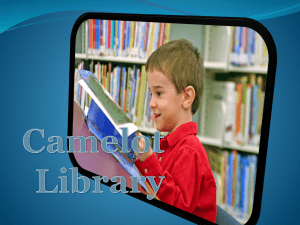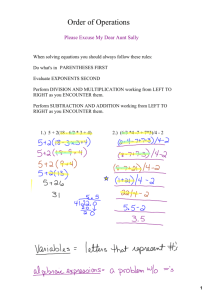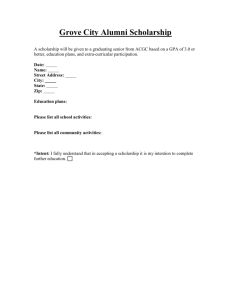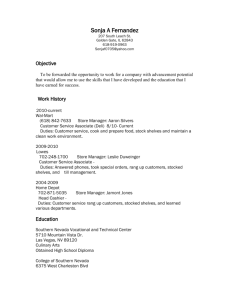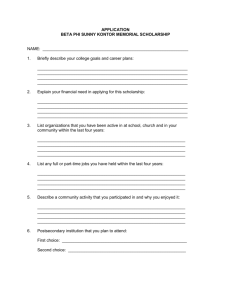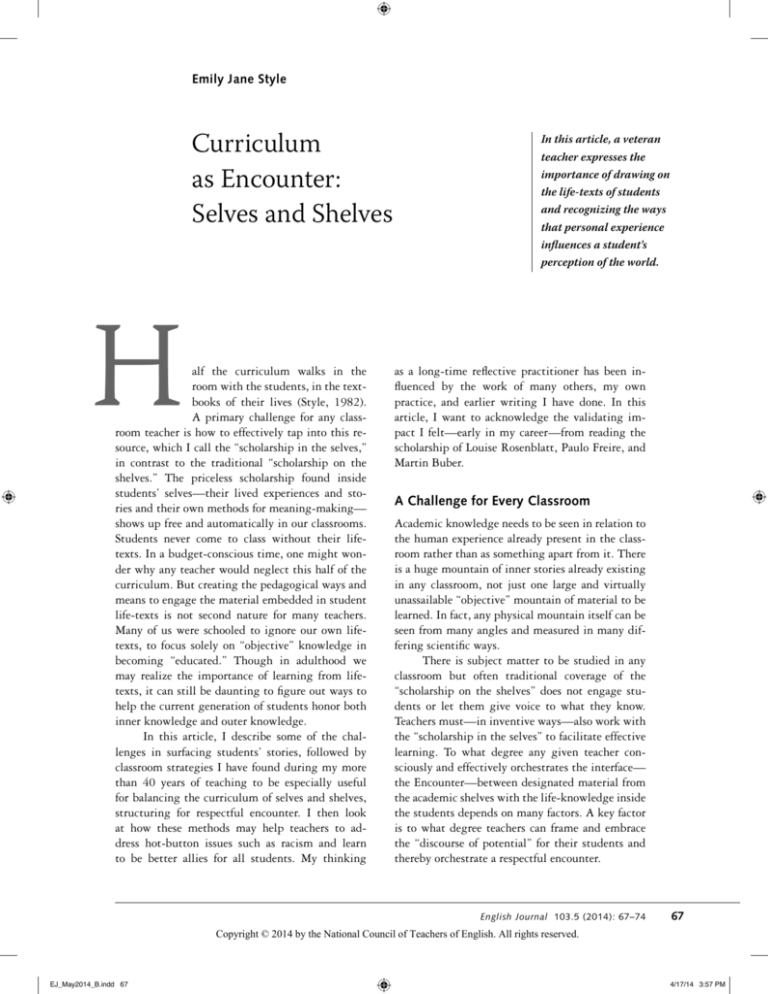
Emily Jane Style
Curriculum
as Encounter:
Selves and Shelves
H
alf the curriculum walks in the
room with the students, in the textbooks of their lives (Style, 1982).
A primary challenge for any classroom teacher is how to effectively tap into this resource, which I call the “scholarship in the selves,”
in contrast to the traditional “scholarship on the
shelves.” The priceless scholarship found inside
students’ selves—­their lived experiences and stories and their own methods for meaning-­making—­
shows up free and automatically in our classrooms.
Students never come to class without their life-­
texts. In a budget-­conscious time, one might wonder why any teacher would neglect this half of the
curriculum. But creating the pedagogical ways and
means to engage the material embedded in student
life-­texts is not second nature for many teachers.
Many of us were schooled to ignore our own life-­
texts, to focus solely on “objective” knowledge in
becoming “educated.” Though in adulthood we
may realize the importance of learning from life-­
texts, it can still be daunting to figure out ways to
help the current generation of students honor both
inner knowledge and outer knowledge.
In this article, I describe some of the challenges in surfacing students’ stories, followed by
classroom strategies I have found during my more
than 40 years of teaching to be especially useful
for balancing the curriculum of selves and shelves,
structuring for respectful encounter. I then look
at how these methods may help teachers to address hot-­button issues such as racism and learn
to be better allies for all students. My thinking
In this article, a veteran
teacher expresses the
importance of drawing on
the life-­texts of students
and recognizing the ways
that personal experience
influences a student’s
perception of the world.
as a long-­time reflective practitioner has been influenced by the work of many others, my own
practice, and earlier writing I have done. In this
article, I want to acknowledge the validating impact I felt—­early in my career—­from reading the
scholarship of Louise Rosenblatt, Paulo Freire, and
Martin Buber.
A Challenge for Every Classroom
Academic knowledge needs to be seen in relation to
the human experience already present in the classroom rather than as something apart from it. There
is a huge mountain of inner stories already existing
in any classroom, not just one large and virtually
unassailable “objective” mountain of material to be
learned. In fact, any physical mountain itself can be
seen from many angles and measured in many differing scientific ways.
There is subject matter to be studied in any
classroom but often traditional coverage of the
“scholarship on the shelves” does not engage students or let them give voice to what they know.
Teachers must—­in inventive ways—­also work with
the “scholarship in the selves” to facilitate effective
learning. To what degree any given teacher consciously and effectively orchestrates the interface—­
the Encounter—­between designated material from
the academic shelves with the life-­knowledge inside
the students depends on many factors. A key factor
is to what degree teachers can frame and embrace
the “discourse of potential” for their students and
thereby orchestrate a respectful encounter.
En­g lish Journal 103.5 (2014): 67–­7 4
67
Copyright © 2014 by the National Council of Teachers of English. All rights reserved.
EJ_May2014_B.indd 67
4/17/14 3:57 PM
Curriculum as Encounter: Selves and Shelves
Embracing the “Discourse of Potential”
I want to relate two stories that I heard from colleagues years ago that illustrate the powerful role
that school teachers can have in framing how students balance selves and shelves. While I am an En­
glish teacher, the stories—­on one level—­are about
teaching physics. As I recall, when one colleague
took high school physics, her teacher began by stating that “Learning physics is like climbing Mount
Everest; many attempt it but few can master it.”
In contrast, another colleague’s high school physics
teacher began by stating, “When you were a baby
in your crib batting a ball around, you were doing
physics, experimenting with momentum and inertia. In this class, you will learn names for things
you have known all your life.”
The first teacher’s way of framing the task is
rooted in what Linda Powell Pruitt calls the “discourse of deficit.” In that framing, subject matter
on academic shelves is seen as huge and the student
learner is minuscule, having little chance to engage
meaningfully. This overpowering, one-­
sided approach to teaching academic content lacks balance
and effectiveness.
The second teacher’s way of framing the task
is rooted in what Pruitt calls the “discourse of potential,” acknowledging that the student is, in fact,
already engaged with the subject matter by virtue
of being alive. Living scholarship is embedded and
embodied in the textbooks of students’ lives. The
teaching task is to effectively orchestrate how the
two types of scholarship, academic and personal—­
shelves and selves—­complement each other. Lucille
Clifton’s poem “study the masters,” featuring the
scholarly life-­text of an enslaved woman who irons
for her master, is one of many literary texts that
probes the positioning of selves and shelves and
status. At any level of schooling, the creation of a
learning community that can artistically hold the
selves in the room as they encounter subject matter
from the historical shelves of knowledge (or today’s
headlines or happenings in their own lives) requires
pedagogical strategies that can balance more than
one type of knowledge, more than one perspective.
This article will now further discuss how
teachers can manage the encounter between the
curriculum found on the shelves and the curriculum housed in the selves, embracing the discourse
68
of potential. It will offer several classroom strategies for doing so and for balancing the multiple
perspectives that such an approach brings to light.
The Name Quiz and Surfacing
Students’ Stories
One way that I have tried to embrace this discourse
and surface students’ stories is by giving a Name
Quiz at the beginning of the school year. On the
first day we meet, I seat students alphabetically in
the outer and inner half-­circles in my classroom.
I give them a print packet of Name Stories, which
include texts such as Sandra Cisneros’s “My Name”
chapter from The House on Mango Street and Maria
Mazziotti Gillan’s poem “Arturo.” In addition to
reading from the “scholarship on the shelves,” their
homework is to research how and why they each
carry the name they do. I tell them I am a mom
with two children, now grown, and I know that a
baby is not born with a name tattooed on her or
his forehead; somehow, a name gets chosen for each
new human being. When I ask how many students
already know their Name Stories, usually less than
a third raise their hands. Often, only a few do. I ask
my students to consider why it is that many of them
have been walking around for 14 or so years with a
name and do not yet know its story. I do not use a
tone of shame, blame, or guilt but I am quietly serious, intending to rigorously raise their awareness:
there’s a there there. Go find it.
On the second day of class, there is time for
those who wish to share their name stories. And I
am fortunate to add to the treasure chest of student
name stories I have enjoyed learning across the years.
Take Eddie’s, for example. He was ten when he and
his Chinese American parents arrived in the United
States. They said he could choose an American name
but it had to be a picture to acknowledge the nature
of his first language. He chose “eddy,” forever filling
that name with watery illumination for me.
The second day of school I also give everyone
a copy of the seating chart with all their names on
it; this is their study guide. I take a photo of each
student to supplement my own study guide because
I need to be able to pass this quiz, too. And I have
about a hundred faces and names to learn.
During the rest of our first week together,
each class spends a few minutes each day preparing
May 2014
EJ_May2014_B.indd 68
4/17/14 3:57 PM
Emily Jane Style
for the quiz, led by students who volunteer to go
around the room and say each classmate’s first name
aloud. I practice aloud, too. Once everyone knows
everyone’s name, I administer that first quiz—­
which is a blank seating chart awaiting the names
of the curriculum-­half that has just arrived. My
students and I never fail to learn interesting material from that basic assessment. We come to see
the wisdom of beginning our journey together by
surfacing their Name Stories and by my modeling a
way of “teaching to the test” that is customized and
local, its own rigorous (and relational) standard.
Dialogue Poems to Balance
Multiple Voices
As the year continues, unearthing multiple perspectives and types of knowledge, teachers must find
ways to balance them all. One helpful method is to
use dialogue poems, which give voice to more than
one voice. These back-­and-­forth poems can be created by students of any age about any subject matter
and specifics about how to do so are readily available
via Google. When I assign the writing of them in my
classroom, I offer published examples such as Paul
Fleishman’s “Honeybees” and Diane Burns’s “Sure,
You Can Ask Me a Personal Question” as well as dialogue poems written by previous students of mine
if they have given me permission to do so, as Alex
Gockel did about her 2006 poem printed below.
Why don’t you look like your parents?
Adopted children don’t.
Can you speak Chinese?
I’m not Chinese; I’m Korean; and no, I don’t speak Chinese.
Do you miss your real parents?
I live with my real parents.
No, I mean your real mom and dad.
I never knew my biological parents.
Would you ever want to meet your real parents?
Biological.
Would you ever want to meet your biological parents?
My biological parents wanted me to have a better life.
conversation, a meditation on something by oneself
alone. Dialogue poems can be a powerful way to display or unpack Curriculum as Encounter. I will illustrate this further with a dialogue poem I wrote and
the story behind it, as I shift gears in this reflective
article to talking about some learning I have done
related to my professional work with other teachers.
After I had been in the classroom for more
than 30 years and working with other teachers as
the codirector of the National S.E.E.D. (Seeking
Educational Equity & Diversity) Project on Inclusive Curriculum (http://www.nationalseedproject.
org) for more than a decade, I had a painful and
illuminating encounter with a teabag. This teabag
can be found in many American grocery stores.
I first encountered the teabag, however, at lunch on
the first day of a diversity training I was directing.
An African American teacher was irate that this
teabag was routinely displayed on the lunchroom
shelf as just another beverage choice. I am a white
teacher and I was clueless about why such an ordinary teabag would ignite such vehemence. How
in the world, this African American teacher asked,
could I be offering this tea at diversity training?
The name of the tea was Plantation Mint.
As a language arts teacher, I have often differentiated between the denotative and connotative
meanings of words—­but this encounter provoked
me to go beyond words to the fact that my white
identity location in relation to the name of this
tea was different from the black teacher’s. In that
lunch moment, her life-­text and mine were not located in the same plane of experience. Friction—­not
warmth—­
was generated between us. Clearly, my
understanding of the situation needed deepening. I
turned to the strategy of writing a dialogue poem to
study further both the selves (hers and mine) and the
shelves (i.e., the “curriculum” found in public view
on society’s grocery shelves) in this inflammatory situation, which had caught me completely by surprise.
Words in bold in the following poem are printed on
individual Plantation Mint teabag packages made by
the American company R.C. Bigelow, Inc. of Fairfield, Connecticut. The non-­bold words are mine.
What do you think it’d be like if you were still with them?
I’m happy where I am, with who I am.
To Sip or Not To Sip: Plantation Mint
—­my dialogue with a tea bag
While a dialogue poem can juxtapose multiple voices
as Alex’s poem does, it can also feature an internal
Plantation—­a big sprawling word—­
with a history, very American
English Journal
EJ_May2014_B.indd 69
69
4/17/14 3:57 PM
Curriculum as Encounter: Selves and Shelves
For three generations, the Bigelow family has specialized in creating a variety of deliciously
different teas. In Plantation Mint, we use only
the finest mountain-­grown tea blended with natural spearmint. We hope you enjoy it.
What is planted
comes to harvest
by way of the hands of
plantation workers
Ingredients: black tea, spearmint
On the plantation porch,
who might sip
Plantation Mint
and who might not?
Please tear here
This is not a hands-­off subject
Ask aloud
if allowed
to add hot water
Steep 1–­2 minutes
Be careful: you could burn your hand
or your lip
if you thoughtlessly sip
fresh and flavorful
Plantation Mint
For now, this particular cup of tea will steep a bit;
we’ll return later to ponder it further.
An Old Fable and a Better Method:
The Go-­Round
Teachers can see the value of another helpful
method for eliciting and responding to various
texts (which I call the 7-­ways) by recalling an old
fable told about six blind men encountering an elephant. From distinct locations, each character grabs
ahold of the large unknown (to him) object under
study: touching knee, side, trunk, tusk, tail, and
ear. When one of the characters walks smack into
the elephant’s side, he concludes, for example—­in
John Godfrey Saxe’s narrative poem version—­that
the elephant “is very like a wall!” Individually, each
character in this story reasons intelligently from
sensory data in hand, linking phenomena under
70
study to something else in his experience. Two
powerful ways of knowing, observation and prior
experience, join forces to bring the unknown into
view, to explain a new phenomenon. What results,
however, is hugely inaccurate about the big picture.
Alas, there are as many versions of the elephant as
there are characters who erroneously conclude—­in
the isolation of their minds—­
that the elephant
definitely and absolutely resembles a wall, a tree, a
snake, a spear, a rope, or a fan.
Unfortunately, these men seem to know no
other way to encounter one another’s ideas than
to stubbornly debate the matter of who is absolutely right. Clearly, this ancient parable is a case
of non-­dialogue. What the characters have in common is intellectual blindness, held in place by their
belief in their own hands-­on (but partial) version
of something, seeing it as being the only and superior truth. And not one of them listens with a
commitment to grasp or try to understand anyone
else’s data or location. What they each possess is an
“educated” provincial arrogance; what they lack is
a conversational (educational) structure that insists
on a balance of listening and speaking, a taking of
turns—­which could further inform both their individual and collective learning. They need practice
at playing, what Peter Elbow calls, the Believing Game as a corrective to the domination of the
Doubting Game. The capacity to encounter the
unknown, something bigger than any one person
can grasp alone (including the societal systems of
racism or sexism or heterosexism—­in which both
selves and shelves are situated) is limited by a individualistic approach to reality and by the habit
of shouting others down. As I reflect on my own
schooling experience as a high school debater who
learned to “kill” people with words, I question the
degree to which American schooling still inculcates
shouting others down as a “winning” pathway to
knowledge. And I wonder to what degree the current, often non-­productive practice of national politics is a product of that schooling habit. There must
be a better way.
As students of mine from across the years
know well, what the folks in the fable could benefit from is a simple and profound Go-­Round. It
works this way. To capitalize on the various knowledge locations present in any classroom and various
May 2014
EJ_May2014_B.indd 70
4/17/14 3:57 PM
Emily Jane Style
types of cognition as well, one pedagogical device I
designed has students pause—­after encountering a
big elephant, a tiny teabag, or any size text—­and
write a 7-­way response of 250 words. Often this
writing is done as homework.
In doing so, each student documents her or
his knowledge of the situation by being specific,
using the following seven prompts and briefly explaining answer choices reflective of their varied
locations and angles of interpretation: (1) a FACT
that I know about the text in front of me is; (2) an
EMOTION that I feel about this text is; (3) something similar that I’ve experienced or read that I
can LINK to this text is; (4) an OPINION I have
about this text is; (5) thinking imaginatively, I ask
WHAT IF some element of the text were changed
in the following way—­or what if I myself were a
character in the drama, who might I be; (6) what
clarification or motivation QUESTION do I have
about this situation; and (7) last but not least, what
specific APPRECIATION can I express about this
particular text or situation?
As a teacher, I have found that the cognitive
range of these seven prompts invites students to
spread the wings of their minds widely when encountering any subject matter or text even as they
are asked to be concrete and candid about their own
particular perceptions and then to listen to comprehend how others are perceiving the material at hand.
In a conversational Go-­Round, which follows
their time of writing documentation about their
individual encounter, each student publicly states
one of his or her responses, until all seven prompts
are covered. The Go-­Round continues around the
room with students, one by one, offering additional
responses from their individual locations until everyone’s voice has contributed to a quilt of voices,
responding from various angles to the subject being
studied. The collective public data in the room can
then serve as foundational fabric for inclusive cross-­
talk about the big picture of any number of texts or
“elephants” in the room.
Structuring classroom interaction to capitalize on the many ways of seeing that are actually
present in the room makes common and superb
sense. Classroom Go-­Rounds are one pedagogical
and democratic way to balance the “scholarship on
the shelves” with the “scholarship in the selves,” so
as to stitch both types of scholarship into an inclusive curriculum quilt. Go-­Rounds are vital for Curriculum as Encounter.
Using Selves and Shelves to
Address Hot-­Button Issues
At the beginning of this article, I wondered why
any teacher would neglect to acknowledge and
make use of the obvious life-­texts that show up in
the people present in any classroom. My encounter
with tea too hot to sip offers a potent clue about
why silence sometimes cloaks or chokes the textbooks of the lives of students—­and teachers, too.
Unless a capacity for dealing fluently with hot-­
button differences exists, teachers will often avoid
life-­text material that has the potential to burn
not only the threads of collaborative quilt-­making
underway but to send an entire classroom quilt up
in flames.
If the truth be told, one choice many white
teachers in American schools still make is to “simply” not talk about race much, if at all, finding the
subject too hot to handle, though race continues to
exist inside the scholarship
of any and all selves in any Structuring classroom
and all classrooms in the interaction to capitalize
Land of the Free and the on the many ways of
Home of the Brave. And
seeing that are actually
there also exists voluminous
scholarship on the academic present in the room
shelves about the subject makes common and
matter of race in America, superb sense.
where phenomena such as
micro-­aggression and stereotype threat, for example,
are explained in detail. So, I ask—­related to Curriculum as Encounter and balancing attention to selves
and shelves—­how do we deal with the teaching gap
between what is known about the subject matter of
race and the capacity of ordinary well-­meaning white
classroom teachers to actually talk about (our) race in
relation to the subject?
One strategy I use is to bring a birdcage into
view. I have found it can help illuminate something
essential about the racial dimension of selves and
shelves. In her 1983 book The Politics of Reality,
scholar Marilyn Frye uses the metaphor of a birdcage to illustrate how a systemic oppression such
English Journal
EJ_May2014_B.indd 71
71
4/17/14 3:57 PM
Curriculum as Encounter: Selves and Shelves
as racism works. Her visual image can help people
start to see, for example, how a tea named Plantation Mint can function as a wire in a birdcage, as
one wire in a network of wires, historical and current. A person caged by the stereotype threat of a
loaded historical term like plantation is not exactly
free to simply ignore its micro-­aggression. It is one
of many micro-­aggressions experienced, one of the
wires that forms a cage of oppression.
The realities of race and other identity locations must be understood on a systems level, as a
network of en-­caging wires to see “the politics of
location,” to use scholar Adrienne Rich’s term,
which come into play among everyone and their
histories in any classroom. Astute teaching about
identity locations (plural) is essential for furthering
the growth and achievement of all students as democratic citizens. Understanding the systemic nature of plural identity locations and how variously
various aspects intersect in the lives of any and all
students and teachers (i.e., the phenomena of intersectionality) is equally important but fleshing
that out further is the subject for another article.
I choose in this article to focus primarily on racial
location because the voices of white teachers who
understand and effectively teach about this terrain
are much needed.
Marilyn Frye’s birdcage metaphor provides a
way to grasp at a glance how differently located a
free-­flying being (not subjected to stereotype threat
or micro-­aggressions) is from one en-­caged and to
see the (white or male or straight) privilege of flying
free, being “normal.” Because American democracy
is still a work-­in-­progress, it is critical that we teach
directly about ongoing efforts to dismantle, wire
by wire, historically oppressive “birdcages” such as
racism, which still imprison aspects of student and
teacher identity in both inner and outer ways. As
students examine literature and speak about the
stories they carry, bringing the scholarship of themselves into the classroom—­their speaking out can
help to dismantle the birdcages found in their inner
worlds (internalized oppression) as well as birdcages
that operate in the world around them.
Nurturing Allies
The classroom oblivion of free-­
flying “birds”—­
whose politics of location, through no fault of their
72
own, can mean that they have never known or noticed the “invisible” cages in which some other
“birds” exist—­can be transformed into citizenship
agency, once students are taught to see systemically. What free-­flyers do not know and do not even
know they don’t know (what Pruitt calls DKDK)
can come into view not only by being introduced
to Frye’s birdcage metaphor but by being awakened
at the same time to everyone’s capacity for being an
ally. This capacity is a potent latent power, which
all free-­flyers possess but of which they are often
unaware. So it sits in the classroom, un-­tapped.
Historical examples of ally power, documented in scholarship on the shelves, demonstrate
how identities not caged can choose to use their un-­
caged location, their “privileged” politics of location, to peck away and bend or break a birdcage
wire here or there. When students are taught to see
the existence of systemic oblivion and oppression in
society alongside the concept of ally power, another
generation of American citizens becomes equipped
to actualize democracy’s further development. And
this caliber of teaching is not about shame, blame,
or guilt. It is about the opportunity, responsibility,
and joy of awakening the citizenship agency that
teachers and students can choose to use with the
“free-­flyer” aspects of our identities.
To cite one historical example: When Branch
Rickey, the white (free-­flying) manager of the 1947
Brooklyn Dodgers, saw how the birdcage of racism
imprisoned certain “colored” birds and the American game of baseball itself, he hired black Jackie
Robinson, using his ally power to open the door of
the cage. His courageous ally action made the Land
of the Free closer to what it aspires to be. First Lady
Eleanor Roosevelt’s allying with singer Marian Anderson is another.
Fortunately, there is ample scholarship on the
shelves about the powerful ally concept with plenty
of historical examples of folks who have taken on
the role of ally. But if we do not tap into it, silence
reigns, depriving young Americans of historical
knowledge they’re entitled to, perpetuating an
ignorance of systemic realities unworthy of democratic education. The current generation of students
is not the first to have the opportunity to contribute
to the process of erasing the evil stain of various
oppressions from the fabric of American life. Other
“free-­flyers” before now have done courageous ally
May 2014
EJ_May2014_B.indd 72
4/17/14 3:57 PM
Emily Jane Style
work. More of that inclusive historical truth needs
to be taught so that the young can gain inspirational knowledge from ally role models whose stories and methods are documented on library shelves
and on the Internet, too, for that matter. Students
who are members of at least one targeted group
benefit from such shelf-­knowledge as well, from
their own complex and plural identity locations.
Teachers as Allies for Deepening Student
Awareness of Selves and Shelves
The American philosopher William James once
said that “The greatest revolution . . . is the discovery that human beings, by changing the inner attitudes of their minds, can change the outer aspect of
their lives.” Good classroom teaching involves not
only supporting students’ increased access to outer
knowledge but also must create ways for their inner
knowledge to surface and, indeed, to change as their
human growth and development is fostered—­as the
textbooks of their lives keep on adding chapters, informed by balanced conversation with other selves
and by rigorous attention to scholarship on the
shelves, old and new.
In the real estate business, there is a well-­
known mantra insisting on the importance of location, location, location. Location awareness is also
pivotal—­
across the curriculum—­
for democratic
citizenship education. Specifically, the public forum
of the classroom stage must be created as much from
the students’ inner knowledge and plural identity
locations as it is by the outer knowledge of subject matter, classic and contemporary. Designing
democratic pedagogical strategies that generate and
validate the site-­specific educational wealth that becomes evident during Curriculum as Encounter—­in
any type of classroom, public or private—­is one of
the powerful ways that teachers of all racial hues can
take on the ally role. We can use our adult power to
support and empower the young in their process of
learning the wisdom of going public with the inner
scholarship of themselves and balancing it with
outer scholarship on the shelves. And in this fashion,
each generation takes its turn, stitching its patches
of knowledge into the quilt of human truths.
Years ago, I pictured Curriculum as Encounter, the stitching together of inner and outer sources
of knowledge, as the making of a classroom com-
munity quilt. In 1986, I described my philosophy
of education in a poem titled “The Quilting Challenge: For Every Classroom.” I offer it here with
abundant respect for the vital role that classroom
teachers can and do play every day in stitching democracy further into being.
It works this way
students bring their own cloth patches
teachers provide needles and thread
then learn so-­and-­so’s name
as part of the art
of classroom quilting
Watch as they practice
their stitch in time
fashioning their pieces
creating their own covering
unraveling threads
often re-­stitching
in a curriculum which needles them
but also beckons their involvement
with its production of warmth
For the rank-­and-­file
this is no ordinary production line
rather a sewing circle
gathering regularly
across time
References
Buber, Martin. I and Thou. New York: Scribner, 1970.
Print.
Burns, Diane. “Sure You Can Ask Me a Personal Question.”
Braided Lives: An Anthology of Multicultural American
Writing. St. Paul: Minnesota Humanities Commission, 1991. 65–­66. Print.
Cisneros, Sandra. The House on Mango Street. 1984. New
York: Vintage, 1989. Print.
Clifton, Lucille. “study the masters.” The Collected Poems of
Lucille Clifton 1965–­
2010. Ed. Kevin Young and
Michael Glaser. Rochester: BOA, 2012. 557. Print.
Collins, Brenda Flyswithhawks. “The Process of Knowing
and Learning: An Academic & Cultural Awakening.”
Holistic Education Review 9.4 (Dec. 1996): 35–­39.
Print.
Elbow, Peter. Appendix Essay. “The Doubting Game and
the Believing Game: An Analysis of the Intellectual
Process.” Writing Without Teachers. New York: Oxford
UP, 1973. 147–­91. Print.
Fleishman, Paul. “Honeybees.” Joyful Noise: Poems for Two
Voices. New York: Harper,1988. 29–­31. Print.
Freire, Paulo. Pedagogy of the Oppressed. Trans. Myra B.
Ramos. 1968. New York: Seabury, 1970. Print.
Frye, Marilyn. “Oppression.” The Politics of Reality: Essays in
Feminist Theory. Trumansburg: Crossing, 1983. Print.
English Journal
EJ_May2014_B.indd 73
73
4/17/14 3:57 PM
Curriculum as Encounter: Selves and Shelves
Gillan, Maria Mazziotti. “Arturo.” What We Pass On—­
Collected Poems: 1980–­2009. 1995. Toronto: Guernica, 2010. 58–­59. Print.
Logan, Judy. Teaching Stories. 1997. New York: Kodansha
International, 1999. Print.
McIntosh, Peggy. “Teaching about Privilege: Transforming
Learned Ignorance into Usable Knowledge.” Foreword. Deconstructing Privilege: Teaching and Learning as
Allies in the Classroom. Ed. Kim Case. New York:
Routledge, 2013. Print.
McIntosh, Peggy, and Emily Style. “Social, Emotional, and
Political Learning.” Educating Minds and Hearts:
Social Emotional Learning and the Passage into Adolescence. Ed. Jonathan Cohen. New York: Teachers College Press, 1999. 137–­57. Print.
Pruitt, Linda Powell. “The Achievement (K)not: Whiteness
and ‘Black Underachievement.’” Off-­White: Readings
on Race, Power, and Society. Ed. Michelle Fine, Lois
Weis, Linda C. Powell, and L. Mun Wong. 2nd ed.
1997. New York: Routledge, 2004. 235–­44. Print.
Rich, Adrienne. “Notes toward a Politics of Location.”
Blood, Bread, and Poetry: Selected Prose 1979–­1985.
New York: Norton, 1985. 210–­31. Print.
Rosenblatt, Louise. Literature as Exploration. New York:
Noble, 1938. Print.
—­—­—­. The Reader, the Text, the Poem: The Transactional Theory of the Literary Work. Carbondale: Southern Illinois
UP, 1978. Print.
Roybal Rose, Lillian. “White Identity and Counseling White
Allies About Racism.” Impacts of Racism on White Americans. Ed. Benjamin Bowser and Raymond Hunt.
Thousand Oaks, CA: Sage, 1996. 24–­47. Print.
Russo, Joe. “Sharing Classroom Power: Why We Sit in the
Same Room.” Transformations: The New Jersey Project
Journal. Fall 2001. 25–­38. Print.
Saxe, John Godfrey. “The Blind Men and the Elephant.”
Web. 21 Aug. 2012.
Style, Emily. “Curriculum as Window & Mirror.” Listening
for All Voices: Gender Balancing the School Curriculum.
Summit, NJ: Oak Knoll School, 1988. 6–­12. Print.
—­—­—­. “Resources and Strategies for Doing Window &
Mirror Curriculum Work.” Social Science Record 33.2
(Fall 1996): 35–­42. Print.
Style, Emily Jane. Multicultural Education and Me: The Philosophy and the Process, Putting Product in Its Place.
Madison: University of Wisconsin Teacher Corps
Associates, 1982. Print.
Style, Emily J., with Linda Powell Pruitt. “In Our Own
Hands: Diversity Literacy.” Transformations: The New
Jersey Project Journal (Fall 1995): 64–­84. Print.
Emily Style has been a classroom teacher for more than 40 years; she has also codirected the National S.E.E.D. Project on
Inclusive Curriculum, based at the Wellesley Centers for Women (http://www.nationalseedproject.org), since its beginning in
1987. She can be reached at seedstyle@optonline.net.
R E AD W R IT E T H IN K CO N N E C T IO N Lisa Storm Fink, RWT
Similar to the article, the ReadWriteThink.org lesson plan “Investigating Names to Explore Personal History and
Cultural Traditions” invites students to investigate the meanings and origins of their names to establish their
personal histories and explore the cultural significance of naming traditions. http://www.readwritethink.org/
classroom-­resources/lesson-­plans/investigating-­names-­explore-­personal-­878.html
74
May 2014
EJ_May2014_B.indd 74
4/17/14 3:57 PM


